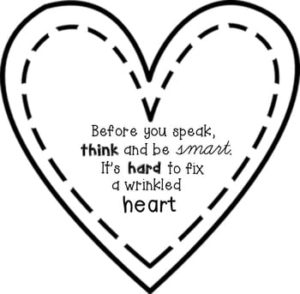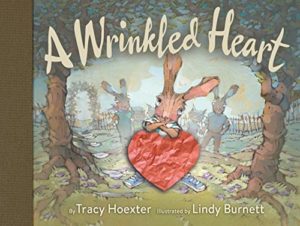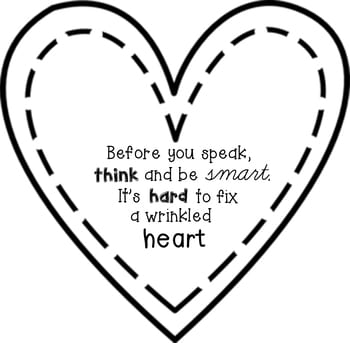Student Contributor: B. Brattin
 The wrinkled heart starts as a simple cut out of a heart and when negative things affect the heart it becomes more and more wrinkled. It is a very helpful tool in the classroom because it gives the students a visual representation of what hurtful words can do.
The wrinkled heart starts as a simple cut out of a heart and when negative things affect the heart it becomes more and more wrinkled. It is a very helpful tool in the classroom because it gives the students a visual representation of what hurtful words can do.
The wrinkled heart should be used as a way of trying to get kids to think before they speak. That is to be cautious of what their words can do to someone’s feelings. The goal of this tool is to not wrinkle the heart. This is done by saying positive things to build the heart up, not negative things that will cause the heart to wrinkle. It is important for kids to know that if they do say something hurtful that wrinkles a heart the right thing to do is to say sorry because although the wrinkle will still be there at least it will be smoothed out because they said sorry. Although it is also important for the kids to know that even though they say sorry about what they said, those words that caused that wrinkled still had an impact on someone and the wrinkle will never be all the gone it will just be smoothed out.
 I placed this tool in the preventative phase because I believe it fits best there. The wrinkled heart is a way of trying to prevent kids of saying hurtful or negative things to others that could potentially hurt their feelings or wrinkle their hearts. It gives them a real-life representation of the power of words and gets them cautiously thinking before they speak, which is a way of trying to prevent hurtful words. This tool relates to the corrective phase in a way because if something negative was spoken then you can correct them by showing them the wrinkle they made and having them take actions to smooth out the wrinkle. That would be a way of correcting their hurtful or negative words. The theory of influence that this tool fits best it student-directed and collaborative. This tool aligns with these theories because the whole class would be involved in making a big classroom heart that would show what words build up positivity for the heart to be strong and wrinkle free. The class and the teacher would come up with all of those positive words and then paste them on the heart so that kids can always look up to the heart and remember that they only want positive words, not negative. The way the teacher and students work together on this tool shows that it would be very collaborative because they are both working on creating the tool together. Also, this tool is very student-directed because the students are very involved with the creation of it and the use of it every day. This tool helps the students be able to make good intentional decisions on their own instead of a teacher simply telling them what words to use and not to use.
I placed this tool in the preventative phase because I believe it fits best there. The wrinkled heart is a way of trying to prevent kids of saying hurtful or negative things to others that could potentially hurt their feelings or wrinkle their hearts. It gives them a real-life representation of the power of words and gets them cautiously thinking before they speak, which is a way of trying to prevent hurtful words. This tool relates to the corrective phase in a way because if something negative was spoken then you can correct them by showing them the wrinkle they made and having them take actions to smooth out the wrinkle. That would be a way of correcting their hurtful or negative words. The theory of influence that this tool fits best it student-directed and collaborative. This tool aligns with these theories because the whole class would be involved in making a big classroom heart that would show what words build up positivity for the heart to be strong and wrinkle free. The class and the teacher would come up with all of those positive words and then paste them on the heart so that kids can always look up to the heart and remember that they only want positive words, not negative. The way the teacher and students work together on this tool shows that it would be very collaborative because they are both working on creating the tool together. Also, this tool is very student-directed because the students are very involved with the creation of it and the use of it every day. This tool helps the students be able to make good intentional decisions on their own instead of a teacher simply telling them what words to use and not to use.
More Information –
Tool Source: Reading: Garrett (2008) Student-centered and teacher-centered classroom management; A case study of three elementary teachers.
https://www.teachstarter.com/blog/national-day-bullying-violence-classroom-activity/


